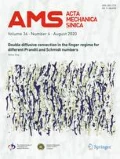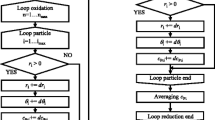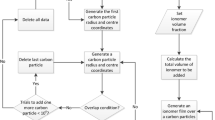Abstract
Particle based models of composite anodes are useful tools for exploring the behavior of SOFC systems. As part of our efforts to develop models for understanding fuel cells, we have been building models of Ni-YSZ composite anodes using experimentally measured particle size distributions. The objectives of this study were to characterize the percolation threshold and conductivity of these models in comparison to simpler mono dispersed and biphasic particle size distributions from the literature. We found that the average values for the onset of percolation and the measured conductivity of the models with experimentally measured particle size distributions are similar to those for the simple distributions and the experimentally measured distributions. For all of the configurations evaluated, the onset of percolation in the Nickel phase occurred at a solid fraction of Nickel between 20% and 25%. This corresponded almost exactly to the point at which the coordination number between Nickel phase particles reached 2.2. The significant finding was that the variation in the value for the conductivity, as measured by the standard deviation of the results, was several orders of magnitude higher than for the simpler systems. We explored the validity of our assumptions, specifically the assumption of random particle placement, by building a particle model directly from FIB-SEM data. In this reconstruction, it was clear that the location of particles was not random. Particles of the same type and size had much likelihood of contact higher than would indicated by random location.
Similar content being viewed by others
Abbreviations
- l kTPB :
-
TPB length between a cermet particle and the k-th neighboring particle of a different conduction type, m
- α :
-
Acceptance ratio for determining the advancement of a Metropolis-Hasting Markov chain
- \(\bar F\) :
-
Force acting on a particle, N
- \(\bar F_D \) :
-
Damping force acting on particle, N
- \(\bar F_N \) :
-
Normal force acting on particle, N
- \(\bar x\) :
-
Vector location of a particle (x; y; z)
- \(\bar x_i \) :
-
Vector location of particle i (x; y; z)
- \(\dot \omega _{e^ - } \) :
-
Net rate of production of electrons at the TPB per unit length, mol/(s·m)
- µ:
-
Mean of a probability distribution
- Φ k :
-
Electrical potential of the k-th neighboring particle of same conduction type, V
- ρ :
-
Standard deviation of a probability distribution
- d :
-
Distance between two particles, m
- d 0 :
-
Desired distance between two particles, m
- d max :
-
Maximum distance between two particles which are in contact, m
- d min :
-
Minimum allowed distance between two particles, m
- G :
-
Conductance, S
- G i-j :
-
Conductance between two particles, S
- i F :
-
Faradaic current across a cermet particle, A
- i R :
-
Resistive current across a cermet particle, A
- i net :
-
Net Current across a cermet particle, A
- N s :
-
Number of intersecting particles of the same conduction type
- N TPB :
-
Number of intersecting particles of a different conduction type
- r i :
-
Radius of particle i, m
- R k :
-
Resistance between a particle and the k-th neighboring particle of the same conduction type, Ω
- X :
-
Sample from a given distribution
- X i :
-
i-th ample from a given distribution in a sequence
- X g :
-
Sample from a normal distribution
- x i x :
-
coordinate of particle i, m
- y i y :
-
coordinate of particle i, m
- Z :
-
Overall average coordination number
- Z e :
-
Average coordination number for electronically conducting particles
- Z i :
-
Average coordination number for ionically conducting particles
- z i :
-
z-coordinate of of particle i, m
- Z e-e :
-
Average coordination of electronically conducting particles with other electronically conducting particles
- Z i-i :
-
Average coordination of ionically conducting particles with other ionically conducting particles
References
Sunde, S.: Calculation of conductivity and polarization resistance of composite SOFC electrodes from random resistor networks. Journal of the Electrochemical Society 142, L50–L52 (1995)
Sunde, S.: Monte Carlo simulations of conductivity of composite electrodes for solid oxide fuel cell. Journal of the Electrochemical Society 143, 1123–1132 (1996)
Sunde, S.: Monte Carlo simulations of polarization resistance of composite electrodes for solid oxide fuel cell. Journal of the Electrochemical Society 143, 1930–1939 (1996)
Bennett, C.H.: Serially deposited amorphous aggregates of hard spheres. Journal of Applied Physics 43, 2727–2741 (1972)
Sunde, S.: Simulations of composite electrodes in fuel cells. Journal of Electroceramics 142, 153–182 (1999)
Costamanga, P., Costa, P., Antonucci, V.: Micro-modelling of solid oxide fuel cell electrodes. Electrochimica Acta 43 375–394 (1997)
Martin, C.L., Schneider, L.C.R., Olmos, L., et al.: Discrete element modeling of metallic powder sintering. ScriptaMaterialia 55, 425–428 (2006)
Martin, C.L., Bouvard, D., Shima, S.: Study of particle rearrangement during powder compaction by the discrete element method. Journal of the Mechanics and Physics of Solids 51, 667–693 (2002)
Schneider, L.C.R., Martin, C.L., Bultel, Y., et al.: Percolation effects in functionally graded SOFC electrodes. Electrochimica Acta 52, 3190–3198 (2006)
Dees, D.W., Claar, T.D., Easier, T.E., et al.: Conductivity of porous Ni/ZrO2-Y2O3 cermets. Journal of the Electrochemical Society 134, 2141–2146 (1987)
Kawashima, T., Hishinuma, M.: Analysis of electrical conduction paths in Ni/YSZ particulate composites using percolation theory. Materials Transactions, JIM 37, 1397–1403 (1996)
Schneider, L.C.R., Martin, C.L., Bultel, Y., et al.: Discrete modeling of the electrochemical performance of SOFC electrodes. Electrochimica Acta 52, 314–324 (2006)
Chan, S.H., Chen, X.J., Khor, K.A.: Cathode micromodel of solid oxide fuel cell. Journal of the Electrochemical Society 151, A164–A172 (2004)
Cho, H.J., Choi, G.M.: Effect of milling methods on performance of Ni-Y2O3-stabilized ZrO2 anode for solid oxide fuel cell. Journal of Power Sources 185, 961–966 (2008)
Wilson, J.R., Kobsiriphat W., Mendoza, R., et al.: Threedimensional reconstruction of a solid-oxide fuel-cell anode. Nature: Materials 5, 541–544 (2006)
Metropolis, N., Rosenbluth, A.W., Rosenbluth, M.N., et al.: Equations of state calculations by fast computing machines. Journal of Chemical Physics 21, 1087–1092 (1953)
Hastings, W.K.: Monte Carlo sampling methods using Markov chains and their applications. Biometrika 57, 97–109 (1970)
Brown, P.N., Byrne, G.D., Hindmarsh, A.C.: Vode, a variablecoefficient ode solver. The SIAM Journal on Scientific and Statistical Computing 10, 1038–1051 (1989)
Feng, S., Halperin, B.I., Sen, P.N.: Transport properties of continuum systems near the percolation threshold. Physics Review B 35, 197 (1987)
Argento, C., Bouvard, D.: Modeling the effective thermal conductivity of random packing of spheres through densification. International Journal of Heat andMass Transfer 39, 1343–1350 (1996)
Wilson, J.R., Gameiro, M., Mischaikow, K., et al.: Threedimensional analysis of solid oxide fuel cell Ni-YSZ anode interconnectivity. Microsc. Microanal. 15, 71–77 (2009)
Author information
Authors and Affiliations
Corresponding author
Additional information
The project was partially supported through a MURI from the United States Office of Naval Research
Rights and permissions
About this article
Cite this article
Thomas, V.L. Effect of particle size distribution on particle based composite anode models. Acta Mech Sin 29, 357–369 (2013). https://doi.org/10.1007/s10409-013-0048-8
Received:
Revised:
Accepted:
Published:
Issue Date:
DOI: https://doi.org/10.1007/s10409-013-0048-8




